rear view mirror GMC SIERRA 2006 Owner's Manual
[x] Cancel search | Manufacturer: GMC, Model Year: 2006, Model line: SIERRA, Model: GMC SIERRA 2006Pages: 600, PDF Size: 3.49 MB
Page 1 of 600
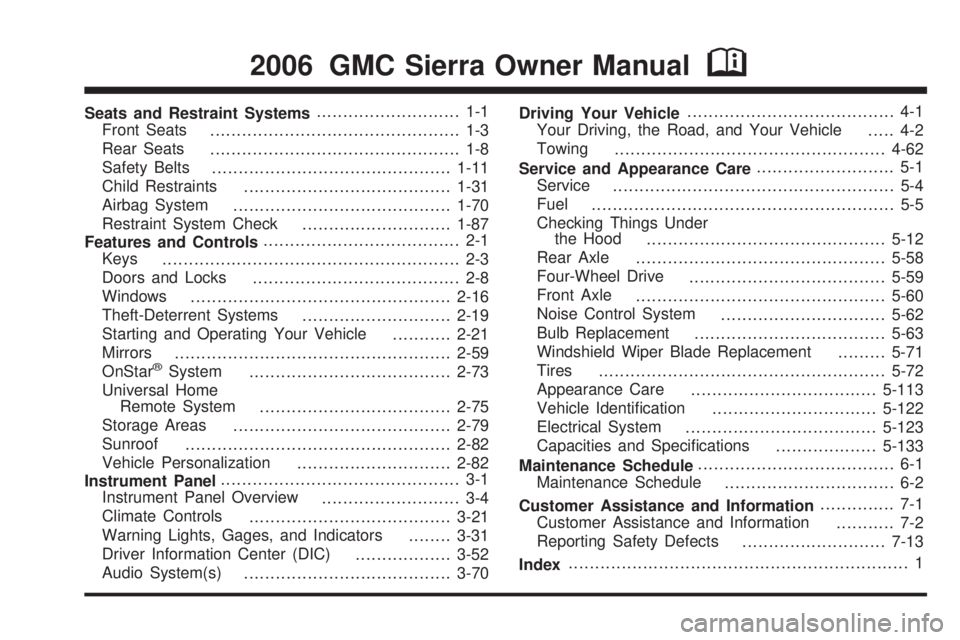
Seats and Restraint Systems........................... 1-1
Front Seats
............................................... 1-3
Rear Seats
............................................... 1-8
Safety Belts
.............................................1-11
Child Restraints
.......................................1-31
Airbag System
.........................................1-70
Restraint System Check
............................1-87
Features and Controls..................................... 2-1
Keys
........................................................ 2-3
Doors and Locks
....................................... 2-8
Windows
.................................................2-16
Theft-Deterrent Systems
............................2-19
Starting and Operating Your Vehicle
...........2-21
Mirrors
....................................................2-59
OnStar
®System
......................................2-73
Universal Home
Remote System
....................................2-75
Storage Areas
.........................................2-79
Sunroof
..................................................2-82
Vehicle Personalization
.............................2-82
Instrument Panel............................................. 3-1
Instrument Panel Overview
.......................... 3-4
Climate Controls
......................................3-21
Warning Lights, Gages, and Indicators
........3-31
Driver Information Center (DIC)
..................3-52
Audio System(s)
.......................................3-70Driving Your Vehicle....................................... 4-1
Your Driving, the Road, and Your Vehicle
..... 4-2
Towing
...................................................4-62
Service and Appearance Care.......................... 5-1
Service
..................................................... 5-4
Fuel
......................................................... 5-5
Checking Things Under
the Hood
.............................................5-12
Rear Axle
...............................................5-58
Four-Wheel Drive
.....................................5-59
Front Axle
...............................................5-60
Noise Control System
...............................5-62
Bulb Replacement
....................................5-63
Windshield Wiper Blade Replacement
.........5-71
Tires
......................................................5-72
Appearance Care
...................................5-113
Vehicle Identi�cation
...............................5-122
Electrical System
....................................5-123
Capacities and Speci�cations
...................5-133
Maintenance Schedule..................................... 6-1
Maintenance Schedule
................................ 6-2
Customer Assistance and Information.............. 7-1
Customer Assistance and Information
........... 7-2
Reporting Safety Defects
...........................7-13
Index................................................................ 1
2006 GMC Sierra Owner ManualM
Page 71 of 600
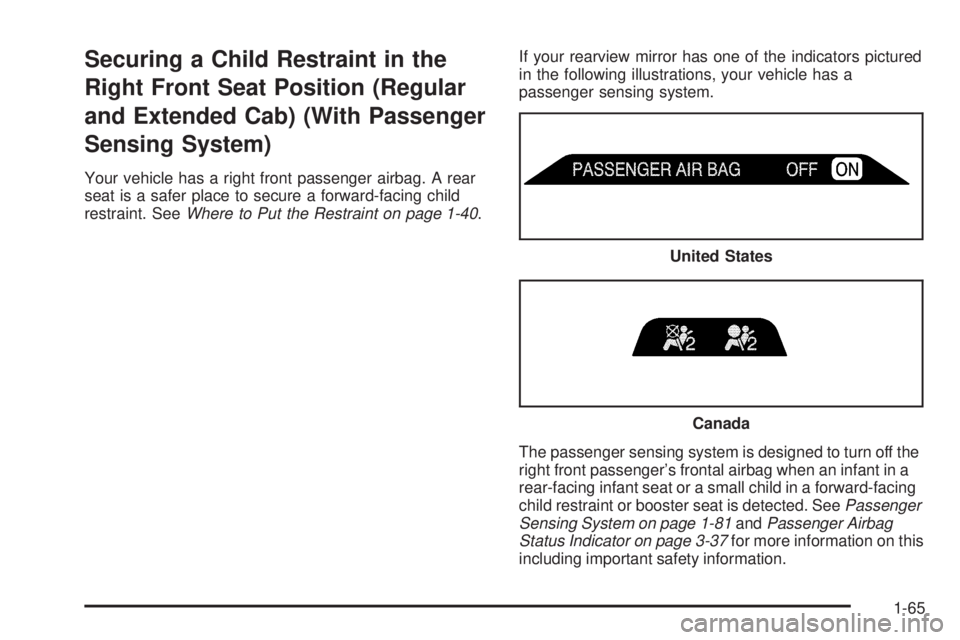
Securing a Child Restraint in the
Right Front Seat Position (Regular
and Extended Cab) (With Passenger
Sensing System)
Your vehicle has a right front passenger airbag. A rear
seat is a safer place to secure a forward-facing child
restraint. SeeWhere to Put the Restraint on page 1-40.If your rearview mirror has one of the indicators pictured
in the following illustrations, your vehicle has a
passenger sensing system.
The passenger sensing system is designed to turn off the
right front passenger’s frontal airbag when an infant in a
rear-facing infant seat or a small child in a forward-facing
child restraint or booster seat is detected. SeePassenger
Sensing System on page 1-81andPassenger Airbag
Status Indicator on page 3-37for more information on this
including important safety information.United States
Canada
1-65
Page 75 of 600
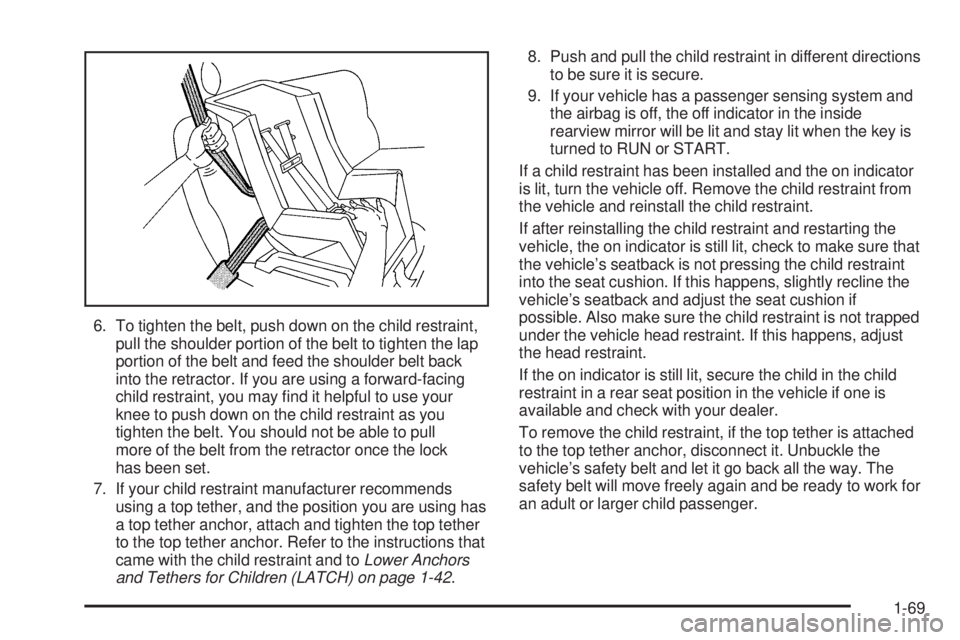
6. To tighten the belt, push down on the child restraint,
pull the shoulder portion of the belt to tighten the lap
portion of the belt and feed the shoulder belt back
into the retractor. If you are using a forward-facing
child restraint, you may �nd it helpful to use your
knee to push down on the child restraint as you
tighten the belt. You should not be able to pull
more of the belt from the retractor once the lock
has been set.
7. If your child restraint manufacturer recommends
using a top tether, and the position you are using has
a top tether anchor, attach and tighten the top tether
to the top tether anchor. Refer to the instructions that
came with the child restraint and toLower Anchors
and Tethers for Children (LATCH) on page 1-42.8. Push and pull the child restraint in different directions
to be sure it is secure.
9. If your vehicle has a passenger sensing system and
the airbag is off, the off indicator in the inside
rearview mirror will be lit and stay lit when the key is
turned to RUN or START.
If a child restraint has been installed and the on indicator
is lit, turn the vehicle off. Remove the child restraint from
the vehicle and reinstall the child restraint.
If after reinstalling the child restraint and restarting the
vehicle, the on indicator is still lit, check to make sure that
the vehicle’s seatback is not pressing the child restraint
into the seat cushion. If this happens, slightly recline the
vehicle’s seatback and adjust the seat cushion if
possible. Also make sure the child restraint is not trapped
under the vehicle head restraint. If this happens, adjust
the head restraint.
If the on indicator is still lit, secure the child in the child
restraint in a rear seat position in the vehicle if one is
available and check with your dealer.
To remove the child restraint, if the top tether is attached
to the top tether anchor, disconnect it. Unbuckle the
vehicle’s safety belt and let it go back all the way. The
safety belt will move freely again and be ready to work for
an adult or larger child passenger.
1-69
Page 81 of 600
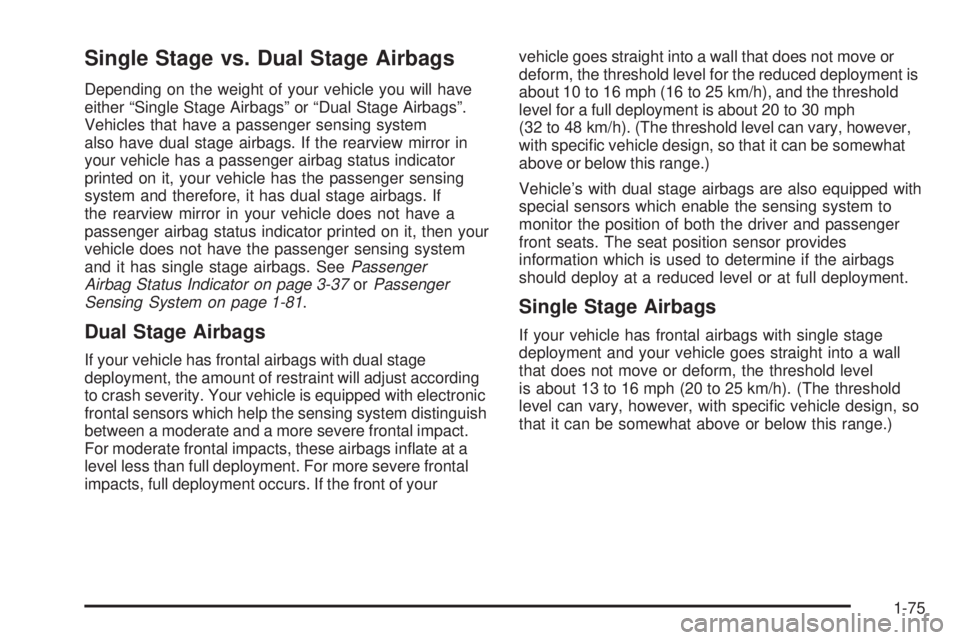
Single Stage vs. Dual Stage Airbags
Depending on the weight of your vehicle you will have
either “Single Stage Airbags” or “Dual Stage Airbags”.
Vehicles that have a passenger sensing system
also have dual stage airbags. If the rearview mirror in
your vehicle has a passenger airbag status indicator
printed on it, your vehicle has the passenger sensing
system and therefore, it has dual stage airbags. If
the rearview mirror in your vehicle does not have a
passenger airbag status indicator printed on it, then your
vehicle does not have the passenger sensing system
and it has single stage airbags. SeePassenger
Airbag Status Indicator on page 3-37orPassenger
Sensing System on page 1-81.
Dual Stage Airbags
If your vehicle has frontal airbags with dual stage
deployment, the amount of restraint will adjust according
to crash severity. Your vehicle is equipped with electronic
frontal sensors which help the sensing system distinguish
between a moderate and a more severe frontal impact.
For moderate frontal impacts, these airbags in�ate at a
level less than full deployment. For more severe frontal
impacts, full deployment occurs. If the front of yourvehicle goes straight into a wall that does not move or
deform, the threshold level for the reduced deployment is
about 10 to 16 mph (16 to 25 km/h), and the threshold
level for a full deployment is about 20 to 30 mph
(32 to 48 km/h). (The threshold level can vary, however,
with speci�c vehicle design, so that it can be somewhat
above or below this range.)
Vehicle’s with dual stage airbags are also equipped with
special sensors which enable the sensing system to
monitor the position of both the driver and passenger
front seats. The seat position sensor provides
information which is used to determine if the airbags
should deploy at a reduced level or at full deployment.
Single Stage Airbags
If your vehicle has frontal airbags with single stage
deployment and your vehicle goes straight into a wall
that does not move or deform, the threshold level
is about 13 to 16 mph (20 to 25 km/h). (The threshold
level can vary, however, with speci�c vehicle design, so
that it can be somewhat above or below this range.)
1-75
Page 87 of 600
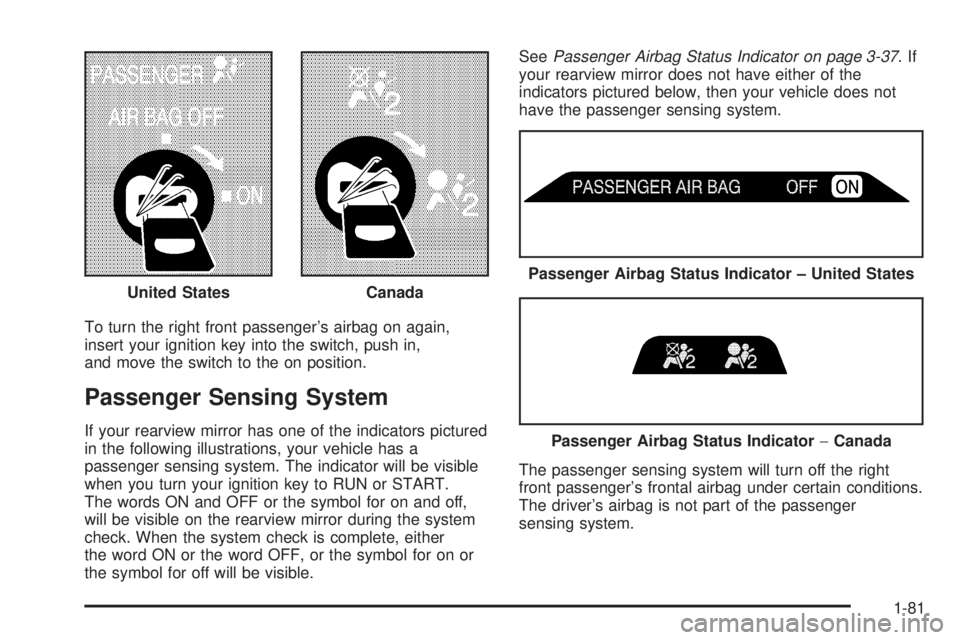
To turn the right front passenger’s airbag on again,
insert your ignition key into the switch, push in,
and move the switch to the on position.
Passenger Sensing System
If your rearview mirror has one of the indicators pictured
in the following illustrations, your vehicle has a
passenger sensing system. The indicator will be visible
when you turn your ignition key to RUN or START.
The words ON and OFF or the symbol for on and off,
will be visible on the rearview mirror during the system
check. When the system check is complete, either
the word ON or the word OFF, or the symbol for on or
the symbol for off will be visible.SeePassenger Airbag Status Indicator on page 3-37.If
your rearview mirror does not have either of the
indicators pictured below, then your vehicle does not
have the passenger sensing system.
The passenger sensing system will turn off the right
front passenger’s frontal airbag under certain conditions.
The driver’s airbag is not part of the passenger
sensing system. United States
Canada
Passenger Airbag Status Indicator – United States
Passenger Airbag Status Indicator−Canada
1-81
Page 93 of 600
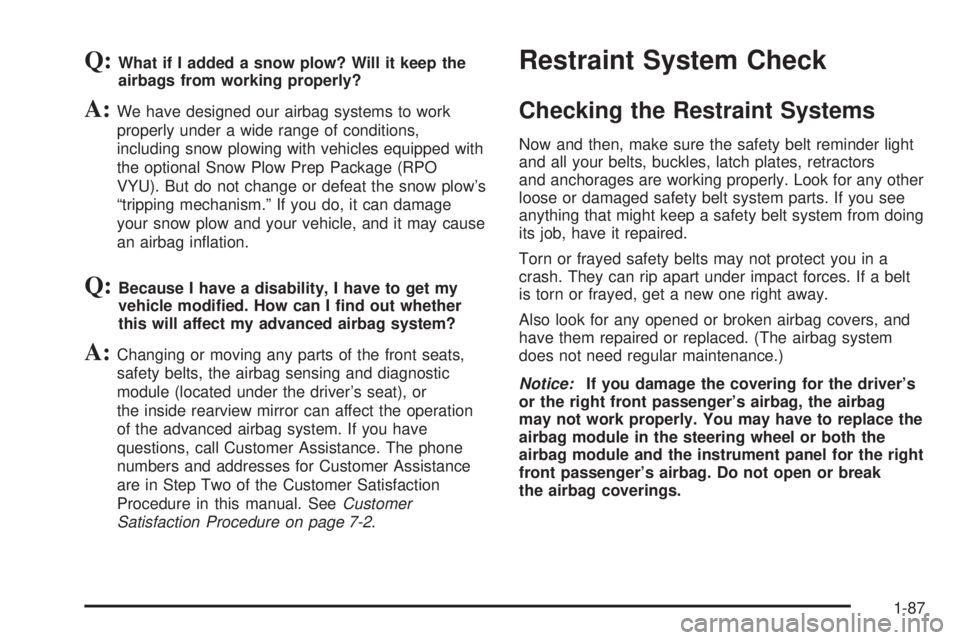
Q:What if I added a snow plow? Will it keep the
airbags from working properly?
A:We have designed our airbag systems to work
properly under a wide range of conditions,
including snow plowing with vehicles equipped with
the optional Snow Plow Prep Package (RPO
VYU). But do not change or defeat the snow plow’s
“tripping mechanism.” If you do, it can damage
your snow plow and your vehicle, and it may cause
an airbag in�ation.
Q:Because I have a disability, I have to get my
vehicle modi�ed. How can I �nd out whether
this will affect my advanced airbag system?
A:Changing or moving any parts of the front seats,
safety belts, the airbag sensing and diagnostic
module (located under the driver’s seat), or
the inside rearview mirror can affect the operation
of the advanced airbag system. If you have
questions, call Customer Assistance. The phone
numbers and addresses for Customer Assistance
are in Step Two of the Customer Satisfaction
Procedure in this manual. SeeCustomer
Satisfaction Procedure on page 7-2.
Restraint System Check
Checking the Restraint Systems
Now and then, make sure the safety belt reminder light
and all your belts, buckles, latch plates, retractors
and anchorages are working properly. Look for any other
loose or damaged safety belt system parts. If you see
anything that might keep a safety belt system from doing
its job, have it repaired.
Torn or frayed safety belts may not protect you in a
crash. They can rip apart under impact forces. If a belt
is torn or frayed, get a new one right away.
Also look for any opened or broken airbag covers, and
have them repaired or replaced. (The airbag system
does not need regular maintenance.)
Notice:If you damage the covering for the driver’s
or the right front passenger’s airbag, the airbag
may not work properly. You may have to replace the
airbag module in the steering wheel or both the
airbag module and the instrument panel for the right
front passenger’s airbag. Do not open or break
the airbag coverings.
1-87
Page 96 of 600
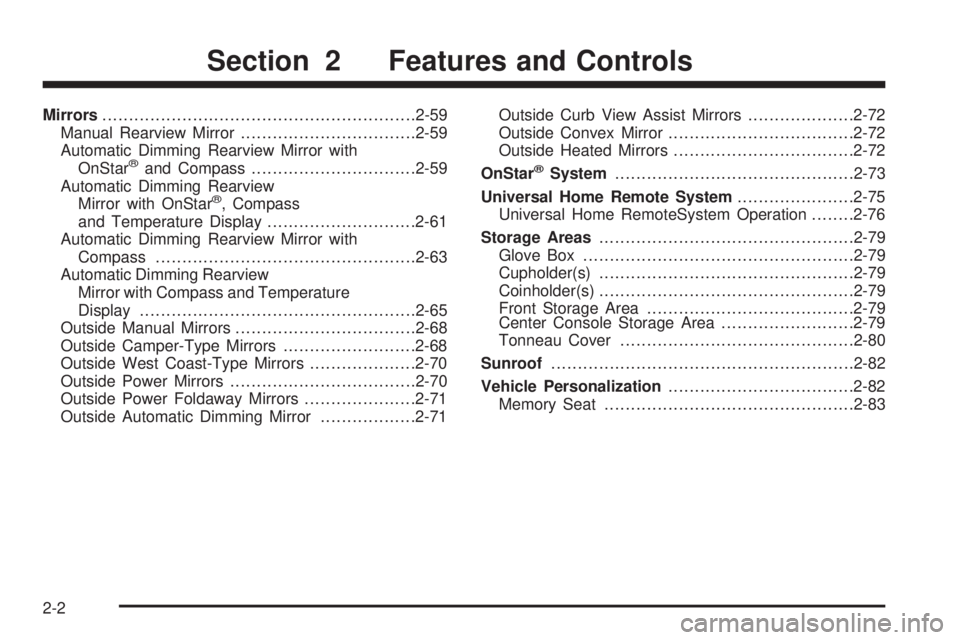
Mirrors...........................................................2-59
Manual Rearview Mirror.................................2-59
Automatic Dimming Rearview Mirror with
OnStar
®and Compass...............................2-59
Automatic Dimming Rearview
Mirror with OnStar
®, Compass
and Temperature Display............................2-61
Automatic Dimming Rearview Mirror with
Compass.................................................2-63
Automatic Dimming Rearview
Mirror with Compass and Temperature
Display....................................................2-65
Outside Manual Mirrors..................................2-68
Outside Camper-Type Mirrors.........................2-68
Outside West Coast-Type Mirrors....................2-70
Outside Power Mirrors...................................2-70
Outside Power Foldaway Mirrors.....................2-71
Outside Automatic Dimming Mirror..................2-71Outside Curb View Assist Mirrors....................2-72
Outside Convex Mirror...................................2-72
Outside Heated Mirrors..................................2-72
OnStar
®System.............................................2-73
Universal Home Remote System......................2-75
Universal Home RemoteSystem Operation........2-76
Storage Areas................................................2-79
Glove Box...................................................2-79
Cupholder(s)................................................2-79
Coinholder(s)................................................2-79
Front Storage Area.......................................2-79
Center Console Storage Area.........................2-79
Tonneau Cover............................................2-80
Sunroof.........................................................2-82
Vehicle Personalization...................................2-82
Memory Seat...............................................2-83
Section 2 Features and Controls
2-2
Page 153 of 600
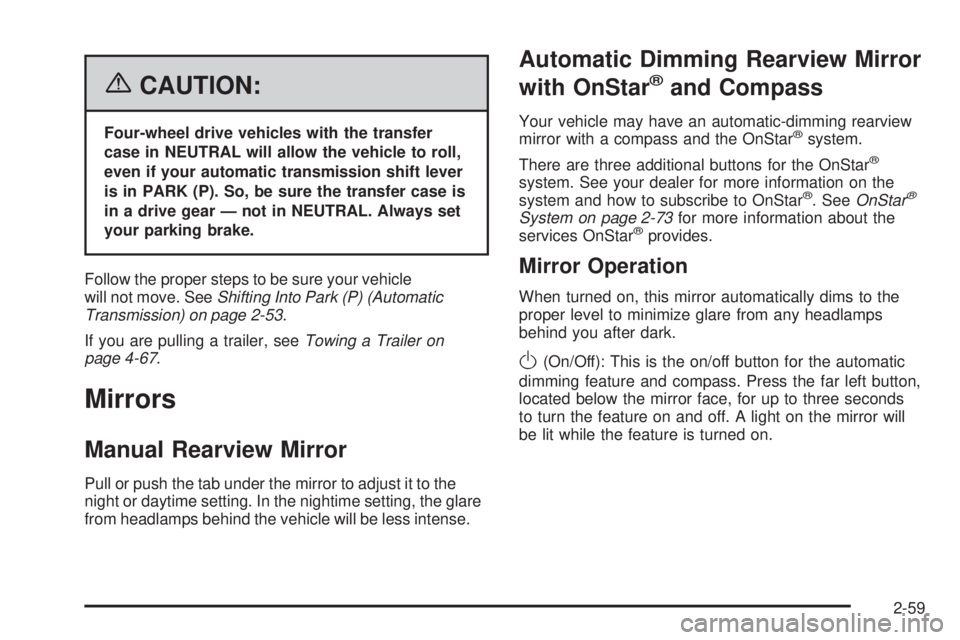
{CAUTION:
Four-wheel drive vehicles with the transfer
case in NEUTRAL will allow the vehicle to roll,
even if your automatic transmission shift lever
is in PARK (P). So, be sure the transfer case is
in a drive gear — not in NEUTRAL. Always set
your parking brake.
Follow the proper steps to be sure your vehicle
will not move. SeeShifting Into Park (P) (Automatic
Transmission) on page 2-53.
If you are pulling a trailer, seeTowing a Trailer on
page 4-67.
Mirrors
Manual Rearview Mirror
Pull or push the tab under the mirror to adjust it to the
night or daytime setting. In the nightime setting, the glare
from headlamps behind the vehicle will be less intense.
Automatic Dimming Rearview Mirror
with OnStar
®and Compass
Your vehicle may have an automatic-dimming rearview
mirror with a compass and the OnStar®system.
There are three additional buttons for the OnStar
®
system. See your dealer for more information on the
system and how to subscribe to OnStar®. SeeOnStar®
System on page 2-73for more information about the
services OnStar®provides.
Mirror Operation
When turned on, this mirror automatically dims to the
proper level to minimize glare from any headlamps
behind you after dark.
O(On/Off): This is the on/off button for the automatic
dimming feature and compass. Press the far left button,
located below the mirror face, for up to three seconds
to turn the feature on and off. A light on the mirror will
be lit while the feature is turned on.
2-59
Page 155 of 600
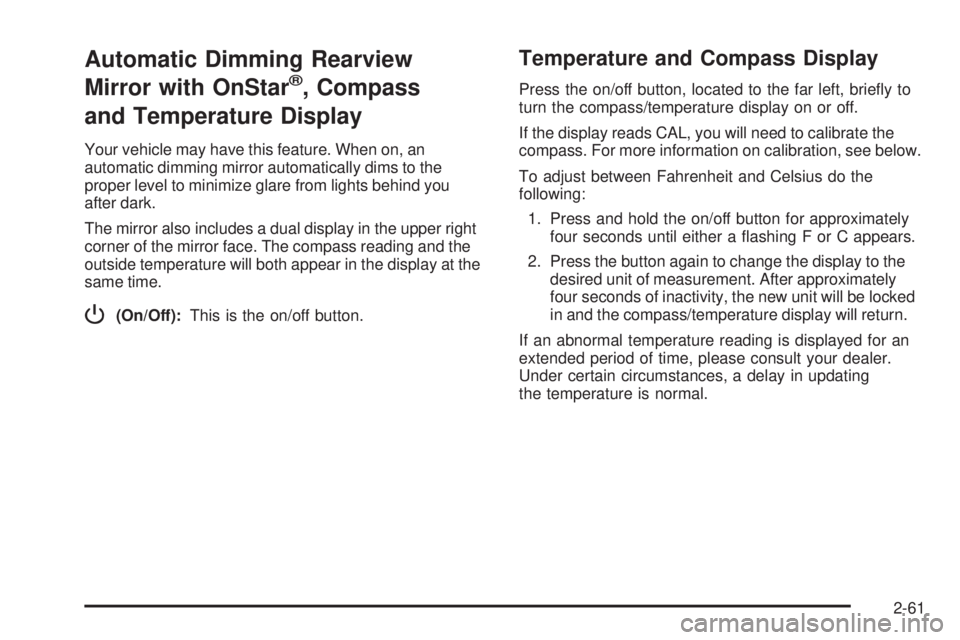
Automatic Dimming Rearview
Mirror with OnStar
®, Compass
and Temperature Display
Your vehicle may have this feature. When on, an
automatic dimming mirror automatically dims to the
proper level to minimize glare from lights behind you
after dark.
The mirror also includes a dual display in the upper right
corner of the mirror face. The compass reading and the
outside temperature will both appear in the display at the
same time.
P(On/Off):This is the on/off button.
Temperature and Compass Display
Press the on/off button, located to the far left, brie�y to
turn the compass/temperature display on or off.
If the display reads CAL, you will need to calibrate the
compass. For more information on calibration, see below.
To adjust between Fahrenheit and Celsius do the
following:
1. Press and hold the on/off button for approximately
four seconds until either a �ashing F or C appears.
2. Press the button again to change the display to the
desired unit of measurement. After approximately
four seconds of inactivity, the new unit will be locked
in and the compass/temperature display will return.
If an abnormal temperature reading is displayed for an
extended period of time, please consult your dealer.
Under certain circumstances, a delay in updating
the temperature is normal.
2-61
Page 157 of 600

3. Keep pressing the on/off button until the desired
zone number appears in the display. Release the
button. After approximately four seconds of inactivity,
the new zone number will be locked in and the
compass/temperature display will return.
4. Calibrate the compass as described below.
Compass Calibration
The compass may need calibration if one of the
following occurs:
After approximately �ve seconds, the display does
not show a compass heading (N for North, for
example), there may be a strong magnetic �eld
interfering with the compass. Such interference may
be caused by a magnetic antenna mount, magnetic
note pad holder or a similar magnetic item.
The compass does not display the correct heading
and the compass zone variance is set correctly.
In order to calibrate, CAL must be displayed in the
mirror compass windows. If CAL is not displayed,
push the on/off button for approximately 12 seconds
or until CAL is displayed.
The compass can be calibrated by driving the vehicle
in circles at 5 mph (8 km/h) or less until the display
reads a direction.
Passenger Airbag Indicator
The vehicle may be equipped with a passenger airbag
indicator, on the mirror glass, just above the buttons.
If the vehicle has this feature, the mirror will display the
word ON, or an airbag symbol in Canada, when the
passenger airbag is enabled. For more information,
seePassenger Sensing System on page 1-81.
Cleaning the Mirror
When cleaning the mirror, use a paper towel or similar
material dampened with glass cleaner. Do not spray
glass cleaner directly on the mirror as that may cause
the liquid cleaner to enter the mirror housing.
Automatic Dimming Rearview Mirror
with Compass
Your vehicle may have an automatic-dimming rearview
mirror with a compass.
2-63